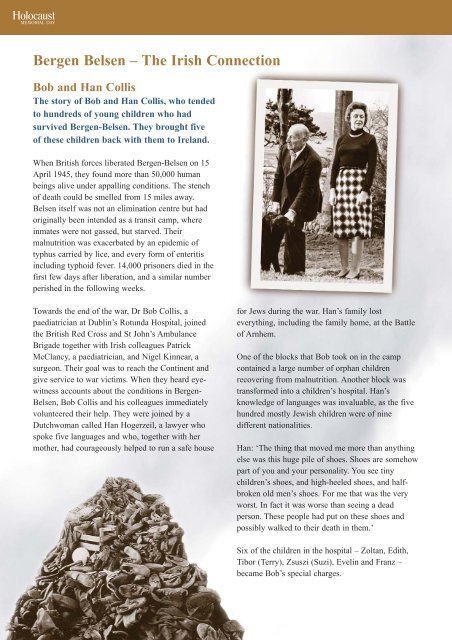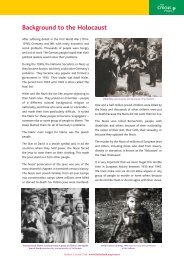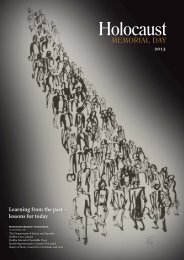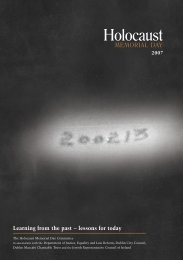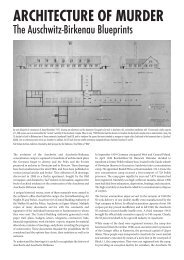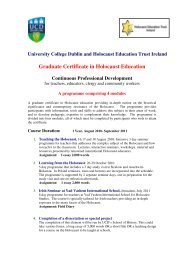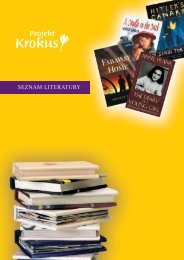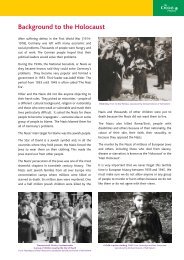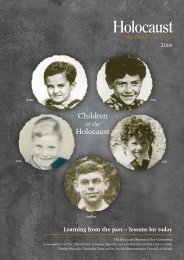Lynn Jackson brochure - Holocaust Education Trust Ireland
Lynn Jackson brochure - Holocaust Education Trust Ireland
Lynn Jackson brochure - Holocaust Education Trust Ireland
Create successful ePaper yourself
Turn your PDF publications into a flip-book with our unique Google optimized e-Paper software.
<strong>Holocaust</strong><br />
MEMORIAL DAY<br />
Bergen Belsen – The Irish Connection<br />
Bob and Han Collis<br />
The story of Bob and Han Collis, who tended<br />
to hundreds of young children who had<br />
survived Bergen-Belsen. They brought five<br />
of these children back with them to <strong>Ireland</strong>.<br />
When British forces liberated Bergen-Belsen on 15<br />
April 1945, they found more than 50,000 human<br />
beings alive under appalling conditions. The stench<br />
of death could be smelled from 15 miles away.<br />
Belsen itself was not an elimination centre but had<br />
originally been intended as a transit camp, where<br />
inmates were not gassed, but starved. Their<br />
malnutrition was exacerbated by an epidemic of<br />
typhus carried by lice, and every form of enteritis<br />
including typhoid fever. 14,000 prisoners died in the<br />
first few days after liberation, and a similar number<br />
perished in the following weeks.<br />
Towards the end of the war, Dr Bob Collis, a<br />
paediatrician at Dublin’s Rotunda Hospital, joined<br />
the British Red Cross and St John’s Ambulance<br />
Brigade together with Irish colleagues Patrick<br />
McClancy, a paediatrician, and Nigel Kinnear, a<br />
surgeon. Their goal was to reach the Continent and<br />
give service to war victims. When they heard eyewitness<br />
accounts about the conditions in Bergen-<br />
Belsen, Bob Collis and his colleagues immediately<br />
volunteered their help. They were joined by a<br />
Dutchwoman called Han Hogerzeil, a lawyer who<br />
spoke five languages and who, together with her<br />
mother, had courageously helped to run a safe house<br />
for Jews during the war. Han’s family lost<br />
everything, including the family home, at the Battle<br />
of Arnhem.<br />
One of the blocks that Bob took on in the camp<br />
contained a large number of orphan children<br />
recovering from malnutrition. Another block was<br />
transformed into a children’s hospital. Han’s<br />
knowledge of languages was invaluable, as the five<br />
hundred mostly Jewish children were of nine<br />
different nationalities.<br />
Han: ‘The thing that moved me more than anything<br />
else was this huge pile of shoes. Shoes are somehow<br />
part of you and your personality. You see tiny<br />
children’s shoes, and high-heeled shoes, and halfbroken<br />
old men’s shoes. For me that was the very<br />
worst. In fact it was worse than seeing a dead<br />
person. These people had put on these shoes and<br />
possibly walked to their death in them.’<br />
Six of the children in the hospital – Zoltan, Edith,<br />
Tibor (Terry), Zsuszi (Suzi), Evelin and Franz –<br />
became Bob’s special charges.


